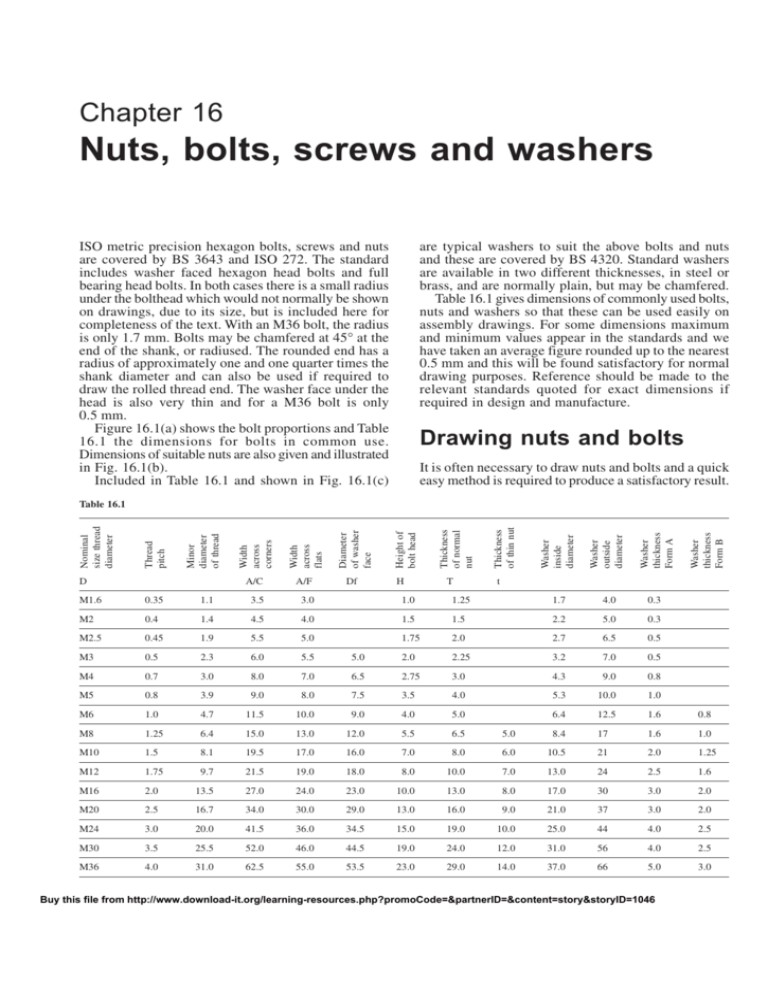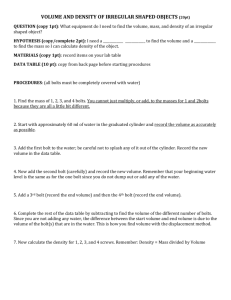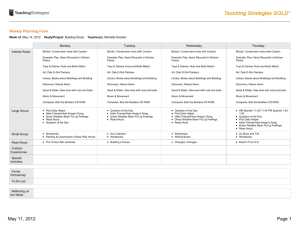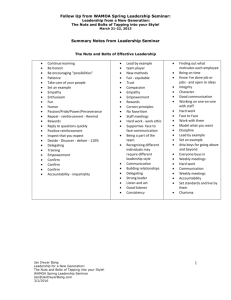
Chapter 16
Nuts, bolts, screws and washers
are typical washers to suit the above bolts and nuts
ISO metric precision hexagon bolts, screws and nuts
and these are covered by BS 4320. Standard washers
are covered by BS 3643 and ISO 272. The standard
are available in two different thicknesses, in steel or
includes washer faced hexagon head bolts and full
brass, and are normally plain, but may be chamfered.
bearing head bolts. In both cases there is a small radius
Table 16.1 gives dimensions of commonly used bolts,
under the bolthead which would not normally be shown
nuts and washers so that these can be used easily on
on drawings, due to its size, but is included here for
assembly drawings. For some dimensions maximum
completeness of the text. With an M36 bolt, the radius
Buy thisis
file
from1.7
http://www.download-it.org/learning-resources.php?promoCode=&partnerID=&content=story&storyID=1046
and minimum values appear in the standards and we
only
mm. Bolts may be chamfered at 45° at the
have taken an average figure rounded up to the nearest
end of the shank, or radiused. The rounded end has a
0.5 mm and this will be found satisfactory for normal
radius of approximately one and one quarter times the
drawing purposes. Reference should be made to the
shank diameter and can also be used if required to
relevant standards quoted for exact dimensions if
draw the rolled thread end. The washer face under the
required in design and manufacture.
head is also very thin and for a M36 bolt is only
0.5 mm.
Figure 16.1(a) shows the bolt proportions and Table
16.1 the dimensions for bolts in common use.
Dimensions of suitable nuts are also given and illustrated
in Fig. 16.1(b).
It is often necessary to draw nuts and bolts and a quick
Included in Table 16.1 and shown in Fig. 16.1(c)
easy method is required to produce a satisfactory result.
Drawing nuts and bolts
Washer
thickness
Form B
Washer
thickness
Form A
Washer
outside
diameter
1.1
3.5
3.0
1.0
1.25
1.7
4.0
0.3
M2
0.4
1.4
4.5
4.0
1.5
1.5
2.2
5.0
0.3
M2.5
0.45
1.9
5.5
5.0
1.75
2.0
2.7
6.5
0.5
M3
0.5
2.3
6.0
5.5
5.0
2.0
2.25
3.2
7.0
0.5
M4
0.7
3.0
8.0
7.0
6.5
2.75
3.0
4.3
9.0
0.8
M5
0.8
3.9
9.0
8.0
7.5
3.5
4.0
5.3
10.0
1.0
M6
1.0
4.7
11.5
10.0
9.0
4.0
5.0
6.4
12.5
1.6
0.8
M8
1.25
6.4
15.0
13.0
12.0
5.5
6.5
5.0
8.4
17
1.6
1.0
M10
1.5
8.1
19.5
17.0
16.0
7.0
8.0
6.0
10.5
21
2.0
1.25
M12
1.75
9.7
21.5
19.0
18.0
8.0
10.0
7.0
13.0
24
2.5
1.6
M16
2.0
13.5
27.0
24.0
23.0
10.0
13.0
8.0
17.0
30
3.0
2.0
M20
2.5
16.7
34.0
30.0
29.0
13.0
16.0
9.0
21.0
37
3.0
2.0
M24
3.0
20.0
41.5
36.0
34.5
15.0
19.0
10.0
25.0
44
4.0
2.5
M30
3.5
25.5
52.0
46.0
44.5
19.0
24.0
12.0
31.0
56
4.0
2.5
M36
4.0
31.0
62.5
55.0
53.5
23.0
29.0
14.0
37.0
66
5.0
3.0
Width
across
flats
0.35
D
Width
across
corners
M1.6
Thread
pitch
Washer
inside
diameter
Thickness
of thin nut
Thickness
of normal
nut
Height of
bolt head
Diameter
of washer
face
Minor
diameter
of thread
Nominal
size thread
diameter
Table 16.1
A/C
A/F
Df
H
T
t
Buy this file from http://www.download-it.org/learning-resources.php?promoCode=&partnerID=&content=story&storyID=1046
d1
H
Length
A/F
d2
Hexagon head
washer faced
Df
D
A/C
Nuts, bolts, screws and washers 121
S
Full bearing head
Rolled thread end
Form A
(c) Bright washers
S
Form B
11 D
4
(a) Hexagon head precision bolts
A/C
Buy this file from http://www.download-it.org/learning-resources.php?promoCode=&partnerID=&content=story&storyID=1046
D
30°
Chamfer
optional
A/F
T
t
(b) Precision nuts and thin nuts
Nuts and bolts are not normally drawn on detail
drawings unless they are of a special type. They are
shown on assembly drawings and, provided they are
standard stock sizes, are called up in parts lists and
schedules. A description of the head, the thread and
the length being generally sufficient. Templates are
available for drawing nuts and bolts and can be
recommended for their time saving advantages.
It is conventional drawing practice to show, as first
choice, nuts and bolts in the across corners position if
a single view only is illustrated since this is instantly
recognizable.
D
0.8D
Proportions of bolts, nuts and washers. A/C means across corners. A/F means across flats.
W
D
W
Fig. 16.1
2D
Approximate construction
for nuts and bolts (Figs
16.2 and 16.3)
Stage 1
1 Draw a circle in the plan position, 2D in diameter,
where D is equal to the thread size. In this example
let us assume that the thread size is M20.
2 Draw a hexagon inside the 40 mm diameter circle
and inside the hexagon draw another circle tangential
to the hexagon on the six sides. This circle is the
projection of the chamfer which can be seen on the
front elevation.
Fig. 16.2
Stage 1
3 the nut thickness is 0.8D. Project the four corners
of the hexagon to the front elevation.
4 Project three corners of the hexagon in the end
elevation and note, that the width of the end elevation
is given by dimension W.
5 Line in the projected diameter of the chamfer circle
and the base in the front elevation.
6 As an approximation, draw a radius to show the
chamfer on the front elevation. The radius should
equal the thread size D.
7 Add the female convention to the plan view.
Buy this file from http://www.download-it.org/learning-resources.php?promoCode=&partnerID=&content=story&storyID=1046
122
Manual of Engineering Drawing
ISO metric socket cap screws
Dimensions in Table 16.2
Stage 2
D
Fig. 16.3
A
These screws are distinguished by square knurling on
the heads. Generally, the lengths of standard screws
increase in increments of 5 mm and 10 mm, but the
exact range should be checked from the manufacturers
catalogue.
Stage 2
Thread
length
K
J
1 The projection of the curve on the chamfered faces
Screw length
H
of the hexagon that lie at an angle would produce
ellipses in the front elevation. In their place we
Fig. 16.4 ISO metric hexagon socket shoulder screws. Dimensions in
Buy this file from http://www.download-it.org/learning-resources.php?promoCode=&partnerID=&content=story&storyID=1046
usually show small circular arcs, their radii can be
Table 16.3
found by trial, but are approximately 0.25D.
2 The end elevation of the nut has square corners and
Table 16.2
the projection of the corner which coincides with
Nominal size D
M3 M4 M5 M6 M8 M10 M12 M16 M20
the centre line terminates at the bottom of the
chamfer curve.
Head diameter A
5.5 7
8.5 10 13 16 18 24
30
3 Complete the view by drawing circular arcs on the
two chamfered faces. Find by trial, the radius of an
Head depth H
3
4
5
6 8 10 12 16
20
arc which will touch the top of the nut and the
Key engagement K 1.3 2
2.7
3.3 4.3 5.5 6.6 8.8 10.7
projection lines from the corner in the front elevation.
3
4
5
6
8
10
14
17
ISO metric hexagon socket shoulder
screws
Dimensions in Table 16.3
Table 16.3
Nominal shoulder diameter B
Head diameter A
6
8
10
12
16
10
13
16
18
24
Head height H
4.5
5.5
7
8
10
Socket size J
3
4
5
6
8
M5
M6
M8
M10
M12
Screw thread diameter D
Nominal thread length Lt
9.75
11.25
13.25
Key engagement K
2.45
3.3
4.15
K
H
16.4
4.92
18.4
6.62
B
It is often required to draw these screws and although
the head type and the length are generally quoted in
parts lists it is necessary to know the proportions of
the head. Dimensions follow for each of the most
commonly used screws.
Before specifying screws it is advisable to consult a
manufacturers list for availability. In the interest of
standardization and economy, designers are urged to
use stock lengths wherever possible and standard lengths
of screws include the following; 3, 4, 5, 6, 8, 10, 12,
16, 20, 25, 30, 35, 40, 45, 50, 55, 60, 65, 70, 75, 80,
90, 100, 110, 120, 130, 140, 150, 160, 170, 180, 190,
and 200 mm. If lengths over 200 mm are required,
then increments of 20 mm are the preferred ISO lengths.
It should be understood that not all diameters of screw
are available in the above lengths. For example, the
range of lengths for an M3 screw lies between 5 and
35 mm, for an M10 screw between 12 and 100 mm for
one particular type of head. The same range will also
not cover different types of head, hence the necessity
to check stock lists.
2.5
D
Socket head screws manufactured to
BS EN ISO 4762 and BS 3643-2
Socket size J
A
Reference to Fig. 16.1a and b will show that the
constructions in Fig. 16.2 and Fig. 16.3 can be used
for the bolthead and locknut where proportions for
thickness can be approximated to 0.7D and 0.5D.
For exact dimensions however, please refer to Table
16.1.
J
L
Lt
Fig. 16.5 ISO metric hexagon socket button head screws. Dimensions in
Table 16.4
Buy this file from http://www.download-it.org/learning-resources.php?promoCode=&partnerID=&content=story&storyID=1046
Chapter extract
To buy the full chapter, and for copyright
information, click here
http://www.download-it.org/learning-resources.php?promoCode=&partnerID=&content=story&storyID=1046
The publisher detailed in the title page holds the copyright for this document
All rights reserved. No part of this publication may be reproduced, stored in a retrieval system, or transmitted,
in any form or by any means, electronic, mechanical, photocopying, recorded or otherwise, without the written
permission of Spenford IT Ltd who are licensed to reproduce this document by the
publisher
All requests should by sent in the first instance to
rights@download-it.org
Please ensure you have book-marked our website.
www.download-it.org




